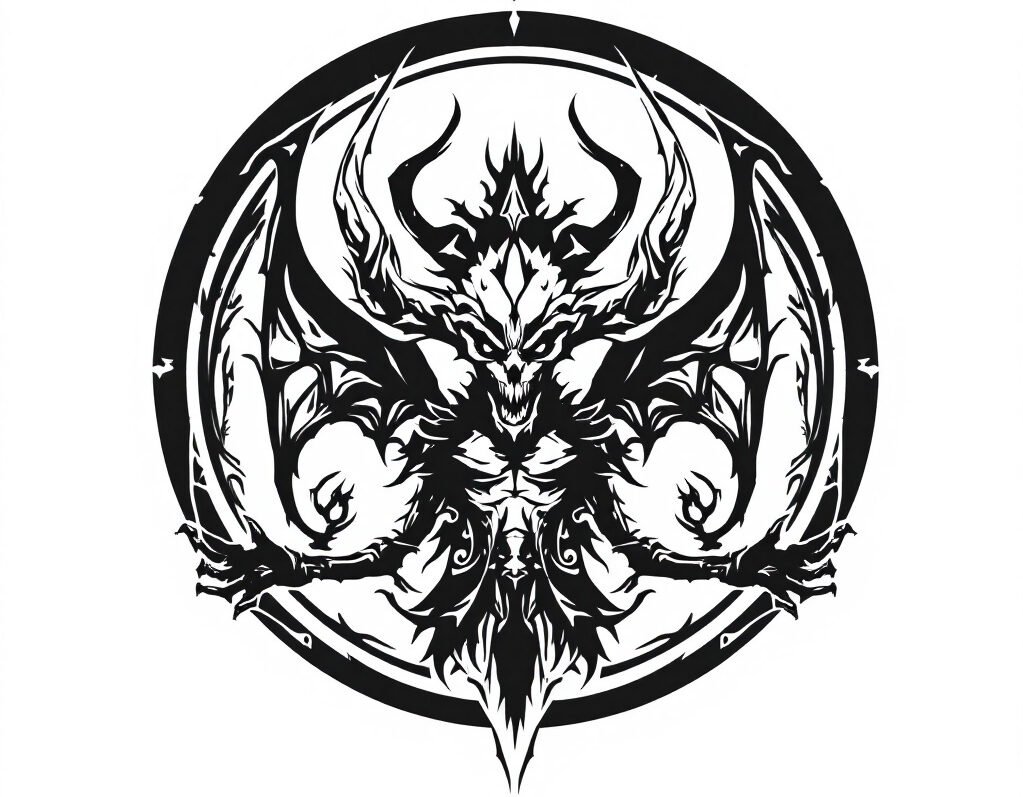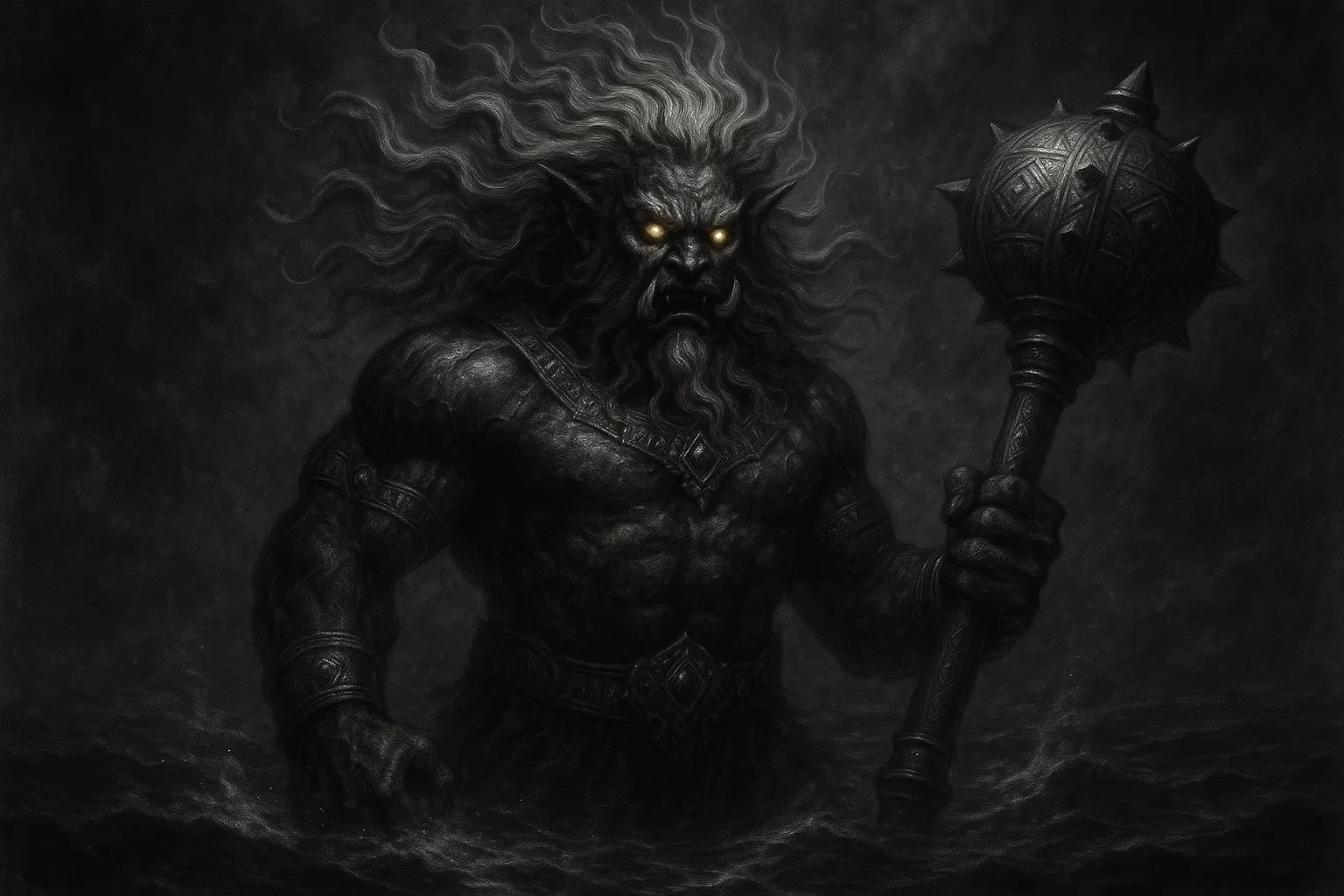Hiranyaksha is a key figure in Hindu myths as an Asura from the Daitya group. He is known for his great strength and for causing big problems in the world by pulling the earth deep into the ocean. This act compelled Vishnu to take the form of a boar (Varaha) to save the earth and combat Hiranyaksha.
As a strong enemy of the gods, he embodies chaos and pride. Still, his story also reveals how order is restored through divine intervention. He is not the main leader of all Asuras, but he holds a high spot among the Daityas as a warrior who tested the gods.
Although not as famous as his brother Hiranyakashipu, Hiranyaksha is mentioned in ancient texts such as the Bhagavata Purana and Vishnu Purana. His tale ties into broader ideas in Hindu stories, such as the struggle between good and evil, and the cycle of avatars where gods intervene to rectify things.
Summary
Key Takeaways
| Attribute | Details |
|---|---|
| Names | Hiranyaksha, Hiranyanetra. |
| Title | Daitya King, Golden-Eyed Demon. |
| Gender | Male. |
| Role | Conqueror, disturber of cosmic order, terrorizer of the three worlds. |
| Clan | Daitya. |
| Followers | Daityas and other Asuras. |
| Powers | Immense strength, invulnerability boon from Brahma, skilled with mace. |
| Appearance | Golden eyes, huge body, golden hair, fearful tusks. |
| Etymology | From Sanskrit: Hiranya means gold, aksha means eye; so golden-eyed. |
| Associated Figures | Parents Kashyapa and Diti; siblings Hiranyakashipu and Holika; consort Rushabhanu; child Andhaka; opponent Vishnu as Varaha; boon-giver Brahma; rescued earth goddess Bhumi. |
| Weaknesses | Boon did not cover death by a boar form, which was not a god, man, or beast. |
| Opposing Deva/Avatar | Vishnu in Varaha form. |
| Pantheon | Hindu, with roots in Vedic and Puranic traditions. |
| Primary Sources | Bhagavata Purana, Vishnu Purana, Taittariya Samhita, Shatapatha Brahmana. |
“Hiranyaksha” Meaning
The name “Hiranyaksha” originates from ancient Sanskrit roots and holds profound significance in Hindu mythology.
In Sanskrit, “hiranya” refers to gold, a metal associated with wealth, light, and power. “Aksha” means eye, so together, the name “Hiranyaksha” refers to someone with golden eyes. This name suits his strong, bright appearance. It hints at his bold nature, as gold often symbolizes purity but is also associated with greed or pride in stories.
In some texts, this powerful Asura is also referred to as Hiranyanetra, which shares the same concept, with “netra” also meaning “eye.” This shows how names in myths often describe key traits.
However, Hiranyaksha’s symbolism extends beyond mere words. It portrays his role as an Asura who radiates power but uses it to cause trouble. For example, in the Bhagavata Purana, his golden eyes reflect his connection to material desires (such as seeking control over the world).
This concept ties into broader ideas, where gold represents earthly things that can lead people astray. Over time, the name has remained the same in most texts. Still, small changes appear in local stories or other languages (such as Tamil, where it may sound slightly different but retains the core meaning).
The etymology of Hiranyaksha traces back to Vedic times, where words like “hiranya” appear in hymns associated with the Sun or riches. For example, in ancient Vedic songs, gold is praised as a gift from the gods, but here it is twisted to reveal an Asura‘s false glory.
This shift highlights how myths evolve, from positive symbols in early texts to warnings about the overuse of power in later ones, like the Puranas.
Variations across texts are few, but some call him just “the golden-eyed one” to stress his fierce gaze in battles. Overall, the name effectively captures his essence as a bright yet dangerous force, reminding readers of the fine line between strength and downfall.
In deeper views, Hiranyaksha’s meaning also connects to cosmic ideas. Gold eyes could mean seeing the world through greed, leading to his act of sinking the earth. This act disrupts balance, showing how personal flaws can harm everything.
The etymology helps explain why Vishnu fights him – to restore harmony. In some interpretations, the golden part is linked to the Sun or fire. Still, his story involves water and earth, creating a contrast. This makes the name a key to understanding his role in the endless cycle of creation and destruction in Hindu thought.
How To Pronounce Hiranyaksha in English
Say it as “Hee-run-yuk-sha,” with stress on the first and third parts. Break it down: “Hee” like in “he,” “run” like the word run, “yuk” like “yuck” without the k sound at the end, and “sha” like “shah.”
What Does Hiranyaksha Look Like?
In Hindu myths, Hiranyaksha is depicted as a massive, fearsome figure with a robust build that suits his role as a warrior Asura. His most striking feature is his golden eyes, which glow with a bright, fierce light, earning him a name that aptly describes this quality.
These eyes are often described as red or shining with anger during fights, making him look even more threatening. He has a large body, covered in golden armor that shines like his name suggests, and he carries a big mace as his main weapon, ready to swing it with great force.
His head has golden hair, adding to his bright but dangerous look, and some stories mention fearful tusks that make him seem like a wild beast. This combines human and animal traits, a common characteristic for Asuras to reveal their wild side.
Interestingly, he is not multi-headed or shape-shifting like some others. Still, his size and strength enable him to tower over his foes. In art, he is often depicted with dark skin or a golden tint, dressed in royal attire to signify his kingly status among the Daityas.
Overall, his look stands for power gone wrong – beautiful in a way with the gold, but twisted by pride and rage.
Origins
Hiranyaksha first appears in post-Vedic texts, but his story has roots in older Vedic ideas about the earth being lifted from the water. He develops as a full character in the Puranas (such as the Bhagavata Purana and Vishnu Purana), where he becomes a key antagonist in Vishnu’s avatar tales.
Over time, his role expands to show themes of chaos versus order, with him as a symbol of pride that challenges the gods. His connection to the cursed gatekeepers, Jaya and Vijaya, adds a layer, making him part of a larger cycle across ages.
In early mentions (like in the Shatapatha Brahmana), the basic plot of a boar saving the earth exists, but without his name. By Puranic times, he gets a clear backstory as a Daitya who gains power through hard work but misuses it.
You may also enjoy:
Bali: The Benevolent Asura King of Hindu Mythology
October 10, 2025
Who Was Abezethibou, the Fallen Angel Who Opposed Moses?
October 1, 2025
Rāga: The Seductive Demon of Passion and Desire in Buddhist Lore
October 16, 2025
Mahakala: The Dark Guardian Who Consumes Evil
October 16, 2025
Iblis, the Jinn King of Darkness and Deception
September 29, 2025
Vritra: The Dragon Who Swallowed the Sky in Hindu Mythology
October 7, 2025
Birth
Hiranyaksha was born to the sage Kashyapa and his wife Diti, who was a daughter of Daksha. Diti wanted strong sons to fight the gods, as she felt jealous of her sister Aditi‘s children, the Devas.
She got pregnant during a time that was not ideal, in the evening, which some say led to her sons being born with dark traits. Hiranyaksha came as the younger son, after his brother Hiranyakashipu. They were part of the Daitya clan, known for their power and fights with the gods.
From a young age, Hiranyaksha showed great strength and a bold spirit. He and his brother learned from their father, but they chose a path of conquest instead of peace.
In the Bhagavata Purana, their birth ties to a curse on Vishnu‘s gatekeepers, Jaya and Vijaya. The Four Kumaras cursed them to be born on earth three times as enemies of Vishnu. In their first life, Vijaya became Hiranyaksha, and Jaya became Hiranyakashipu. This explains why they were so strong yet doomed to face divine wrath.
Their early life happened in the Satya Yuga, a time of truth and order, but they brought chaos. Diti raised them with care, but their nature led them to seek boons through tough penance. Hiranyaksha grew into a warrior, ready to challenge the world.
Family
Hiranyaksha‘s family ties illustrate the intricate relationships between Asuras and gods in Hindu mythology. As mentioned above, his parents were Kashyapa—a wise sage and one of the Saptarishis—and Diti, who came from Daksha’s line.
Kashyapa had many wives, resulting in different clans: the Devas from Aditi and the Daityas from Diti. This made Hiranyaksha part of a vast family tree with both positive and negative aspects. His relationship with his brother, Hiranyakashipu, was close; they shared the same goals of power, but Hiranyakashipu sought revenge after Hiranyaksha’s death.
He had a sister, Holika, known for her role in trying to burn her nephew Prahlada, Hiranyakashipu’s son. Hiranyaksha married Rushabhanu, and they had a son, Andhaka, who later became a strong Asura himself, blinded and adopted by others.
Family bonds drove their actions, as seen in Hiranyakashipu‘s anger over his brother’s loss, which led to further conflicts. Overall, their kin emphasized loyalty among the Asuras but also demonstrated how curses and boons influenced their fates.
| Genealogy | Details |
|---|---|
| Parents | Kashyapa (father), Diti (mother). |
| Siblings | Hiranyakashipu (elder brother), Holika (younger sister). |
| Spouse | Rushabhanu. |
| Children | Andhaka. |
Asura-Deva Conflicts
Hiranyaksha played a significant role in the ongoing conflicts between the Asuras and Devas, which form the core of many Hindu myths. These battles often center on control of the three worlds and upholding dharma, or right order.
Hiranyaksha started trouble by getting a boon from Brahma that made him hard to kill – no god, man, or beast could end him. With this, he attacked the gods and sank the earth into the ocean, causing fear everywhere.
The main clash was with Vishnu in the form of Varaha. The Devas asked Vishnu for help when Hiranyaksha hid the earth goddess Bhumi. Varaha dove into the water, found her, and fought Hiranyaksha in a fierce battle.
Using his mace, Hiranyaksha tried to stop the boar, but Varaha won, killing him and lifting the earth back. This restored balance and showed how divine avatars step in to protect dharma.
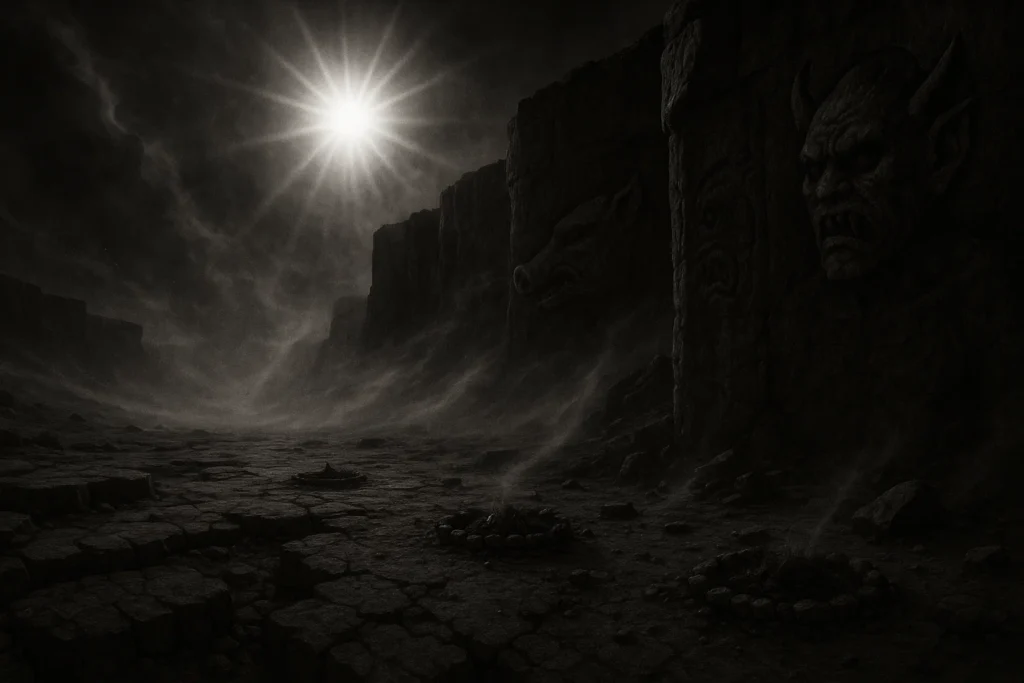
Role in Hindu Cosmology
Hiranyaksha aligns with Hindu concepts of cosmic balance, where Asuras like him disrupt the cycle of dharma, ultimately leading to rebirth and renewal. He acts as a villain who challenges order by sinking the earth, symbolizing how evil can temporarily overwhelm good.
However, his death at the hands of Varaha demonstrates that divine forces always restore harmony. This ties to the yuga cycle, where in Satya Yuga, such threats get handled by avatars to keep the world going.
Although seen as evil, Hiranyaksha has a twist: he is actually Vijaya, a reborn gatekeeper of Vishnu, cursed to oppose him. This makes him part of a plan for redemption, as after three lives as foes, he returns to serve.
His influence touches human affairs by warning against greed and pride, which can sink one’s life like the earth fell. In divine matters, he prompts Vishnu‘s avatars, demonstrating how even evil serves the greater purpose of balance.
You may also enjoy:
Ifrit: Demon of Fire Who Serves Iblis in Islamic Tradition
September 30, 2025
Banasura: The Thousand-Armed Demon King
October 10, 2025
Who Is Aka Manto, Japan’s Terrifying Red-Cloaked Yōkai?
October 24, 2025
The Ghul: The Flesh-Eating Demon of Arabian Folklore
October 1, 2025
Bali: The Benevolent Asura King of Hindu Mythology
October 10, 2025
What Is the Abumi-guchi Yōkai and Why Does It Wait Forever?
October 22, 2025
Was Hiranyaksha Ever Mentioned in Vedic Texts?
Hiranyaksha does not appear by name in the Rig Veda, the Atharva Veda, or other early Vedic texts. His story likely started in later epics and Puranas, building on older ideas about the earth being rescued from water.
Hiranyaksha in Epics and Puranas
Hiranyaksha appears primarily in the Puranas, rather than in epics like the Ramayana or Mahabharata. In the Bhagavata Purana by Vyasa, he is a key foe in Canto 3, where Vishnu as Varaha fights him. Other texts mention him briefly as part of the Avatar stories.
| Source | Quote |
|---|---|
| Bhagavata Purana 3.18.2 | He saw there the all-powerful Personality of Godhead in His boar incarnation, bearing the earth upward on the ends of His tusks and robbing him of his splendor with His reddish eyes. The demon laughed: Oh, an amphibious beast! |
| Bhagavata Purana 3.18.3 | The demon addressed the Lord: O best of the demigods, dressed in the form of a boar, just hear me. This earth is entrusted to us, the inhabitants of the lower regions, and You cannot take it from my presence and not be hurt by me. |
| Bhagavata Purana 3.18.4 | You rascal, You have been nourished by our enemies to kill us, and You have killed some demons by remaining invisible. O fool, Your power is only mystic, so today I shall enliven my kinsmen by killing You. |
| Bhagavata Purana 3.18.14 | Hissing indignantly, all his senses shaken by wrath, the demon quickly sprang upon the Lord and dealt Him a blow with his powerful mace. |
| Bhagavata Purana 3.18.28 | This demon, luckily for us, has come of his own accord to You, his death ordained by You; therefore, exhibiting Your ways, kill him in the duel and establish the worlds in peace. |
| Vishnu Purana (from secondary reference) | Hiranyaksha assaulted the defenceless Bhumi and pulled her deep beneath the cosmic ocean. |
Powers and Abilities
Hiranyaksha is a powerful Asura. His main powers and abilities include:
- Immense Strength: He could pull the entire earth into the ocean and fight gods with ease.
- Invulnerability Boon: From Brahma, he could not be killed by any god, man, or beast, making him nearly unbeatable.
- Combat Skills: Expert with a mace, using it to strike hard blows in battles.
- Endurance: Lasted in long fights, like his duel with Varaha, showing high stamina.
- Terrorizing Presence: His roar and gaze could scare the three worlds, spreading fear.
- Austerity Power: Gained boons through tough penance, showing strong will.
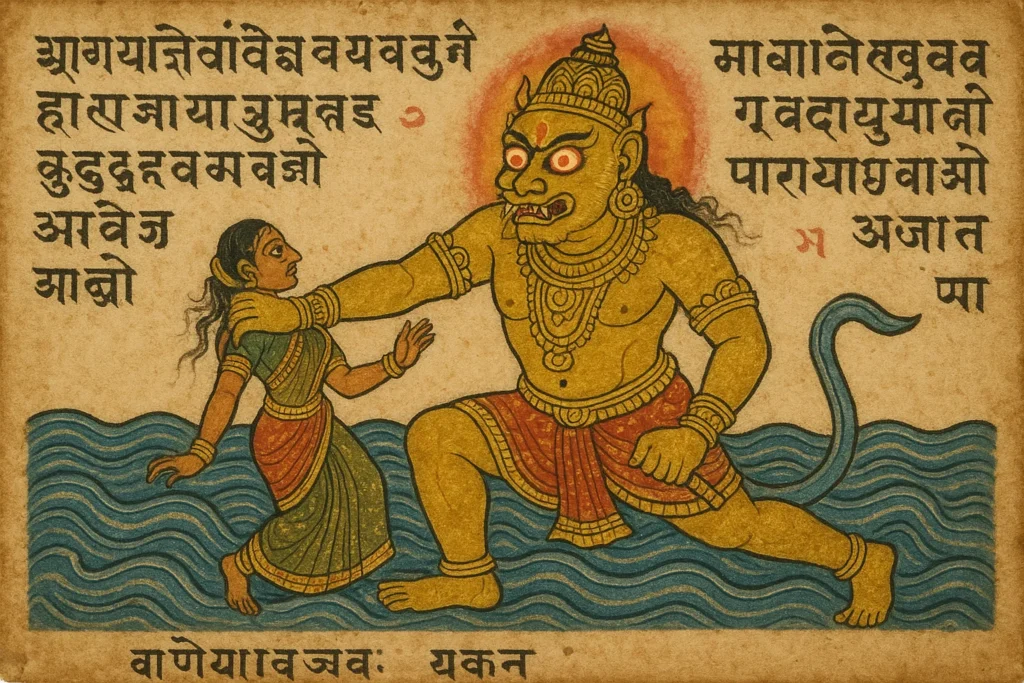
Hiranyaksha Myths, Legends, and Stories
The Battle with Varaha
The proud and wrongly boastful Daitya gave small notice to the advice of Varuna. “O kind Vidura,” he heard from Narada, the location of the Supreme Being. He quickly went to the bottom of the sea himself.
He spotted there the almighty Being of God in its pig form, holding the land up on the tips of its fangs and taking away its shine with its red gaze. The evil one chuckled: “Oh, a creature that lives in water and on land!”
The evil one spoke to the Lord: “O top of the half-gods, clothed in the shape of a pig, just listen to me. This land is given to us, the dwellers of the lower places, and You cannot remove it from my sight without getting harmed by me. You scoundrel, You have been fed by our foes to end us, and You have ended some evil ones by staying hidden. O silly one, Your strength is only magical, so today I will cheer my relatives by ending You.”
The evil one went on: “When You drop lifeless with Your head broken by the club thrown by my limbs, the half-gods and wise ones who give You gifts and offer in loyal service will also stop being, like plants without bases.”
“Though the Lord felt hurt by the arrow-like harsh words of the evil one,” He carried the hurt. But noticing that the land on the tips of His fangs was scarred, He came up out of the liquid just as a big animal comes out with its mate when attacked by a crocodile.
The evil one, who had yellow fur on his top and scary fangs, followed the Lord while He was coming up from the liquid, even as a crocodile would follow a big animal. Bellowing like storm noise, he stated: “Are You not embarrassed of fleeing before a testing foe? There is nothing blameworthy for bold-less beings!”
The Lord put the land within His view on the top of the liquid and passed to her His own force in the shape of the skill to stay on the liquid. While the foe stood watching, Brahma, the maker of the world, praised the Lord, and the other half-gods dropped flowers on Him.
The evil one, who had a lot of jewels, arm bands, and a lovely yellow metal cover on his frame, chased the Lord from the rear with a big club. The Lord bore his sharp bad words, but to answer him, He showed His awful fury.
The Being of God stated: “Indeed, We are beings of the wild, and We are looking after chasing dogs like you. One who is free from the trap of end has no worry from the free talk in which you are taking part, for you are tied up by the rules of end. Surely We have taken the duty of the dwellers of Rasatala and have lost all embarrassment. Though bitten by your strong club, I shall remain here in the liquid for some period because, having made hate with a strong foe, I now have no spot to go.”
“You are meant to be the leader of many foot soldiers,” he continued. “And now you may take swift steps to defeat us. Give up all your silly talk and remove the worries of your close ones by ending Us. One may be proud, yet he does not earn a place in a gathering if he fails to keep his given word.”
Sri Maitreya stated: “The evil one, being thus tested by the Being of God, became mad and stirred, and he shook madly like a tested snake.”
Breathing angrily, all his feelings shaken by anger, the evil one fast jumped upon the Lord and gave Him a hit with his strong club. The Lord, however, by shifting a bit to the side, avoided the hard club hit aimed at His chest by the foe, just as a skilled yogi would avoid an end.
The Being of God now showed His mad and rushed to meet the evil one, who bit his mouth in fury, took up his club again, and began to wave it around over and over.
Then with His club the Lord hit the foe on the right of his forehead, but since the evil one was skilled in combat, O soft Vidura, he guarded himself by a move of his own club.
In this manner, the evil one Haryaksha and the Lord, the Being of God, hit each other with their big clubs, each mad and seeking his own win.
There was sharp competition between the two fighters; both had gotten hurts on their frames from the hits of each other’s pointed clubs, and each became more and more mad at the scent of blood on his self. In their eagerness to succeed, they made moves of different types, and their match looked like a meeting between two strong cows for the sake of a female.
O child of Kuru, Brahma, the most free half-god of the world, with his followers, came to view the awful fight for the good of the globe between the evil one and the Being of God, who showed in the shape of a pig.
After reaching the spot of the fight, Brahma, the head of thousands of wise ones and beyond thinkers, saw the evil one, who had reached such never-before strength that no one could battle with him. Brahma then spoke to Narayana, who was taking the shape of a pig for the first time.
Lord Brahma stated: “My kind Lord, this evil one has shown to be a steady pain to the half-gods, the priests, the animals, and pure people who are spotless and always rely on honoring Your flower feet. He has turned into a source of worry by needlessly bothering them. Since he has gotten a gift from me, he has turned into an evil one, always looking for the right fighter, roaming all over the world for this bad goal.”
Lord Brahma went on: “My kind Lord, there is no need to toy with this snake-like evil one, who is always very good at magic tricks and is proud, self-enough, and most bad.”
Brahma went on: “My kind Lord, You are without fail. Please end this wrong, evil one before the evil hour comes and he shows another strong way, good for him. You can end him with Your inner strength without doubt. My Lord, the darkest night, which hides the globe, is fast coming. Since You are the Spirit of all spirits, kindly end him and gain a win for the half-gods.”
The good time known as Abhijit, which is most beneficial for winning, started at midday and has almost all passed; so, for the sake of your friends, please eliminate this strong enemy quickly.
This evil one, luckily for us, has come of his own will to You, his end set by You; so, showing Your paths, end him in the fight and put the worlds in calm.
Hiranyaksha vs Other Asuras
| Asura Name | Associated Trait/Role | Clan/Origin | Key Traits/Powers |
|---|---|---|---|
| Hiranyakashipu | Vengeance seeker | Daitya | Boon of near-immortality, strength, ruler. |
| Vritra | Drought causer | Danava | Shape-shifting, water control, thunderbolt resistance. |
| Bali | Generous king | Daitya | Devotion, conquest, immortality boon. |
| Ravana | Conqueror of worlds | Rakshasa | Ten heads, sword mastery, flight chariot. |
| Kumbhakarna | Giant warrior | Rakshasa | Huge size, deep sleep, immense strength. |
| Mahishasura | Buffalo demon | Asura | Shape-shifting, army command, boon against men. |
| Narakasura | Earth conqueror | Asura | Weapon mastery, women captor, boon from Brahma. |
| Bhasmasura | Ash-touch destroyer | Asura | Boon to burn by touch, dance trickery. |
| Andhaka | Blind warrior | Daitya | Regeneration, thousand arms/eyes, darkness power. |
| Tarakasura | Three-world ruler | Asura | Boon only Shiva’s son kills him, army leader. |
| Shumbha | Prideful leader | Daitya | Combat skills, illusion, divine weapons. |
| Nishumbha | Brother warrior | Daitya | Strength, boon resistance, fierce battles. |
| Madhu | Primordial demon | Daitya | Immortality boon, Vishnu slayer attempt. |
| Kaitabha | Primordial demon | Daitya | Strength, Vedas thief, illusion creation. |
| Aghasura | Serpent demon | Asura | Poison breath, huge form, child trapper. |
You may also enjoy:
Mahakala: The Dark Guardian Who Consumes Evil
October 16, 2025
Agubanba: The Ash-Born Demon of Japanese Folklore
October 23, 2025
Abura-akago: The Oil-Licking Demon Baby
October 22, 2025
Who Is Abalam in Demonology? The Terrifying King That Serves Paimon
September 30, 2025
What Is the Abumi-guchi Yōkai and Why Does It Wait Forever?
October 22, 2025
Aamon: The Infernal Marquis of Lust, Feuds, and False Prophecies
September 29, 2025
Rank Among Asuras
Hiranyaksha holds a high spot among the Daityas as a key warrior and kingly figure, though not the top leader like some others.
As part of the Daitya clan, born to Diti and Kashyapa, he stands as a strong example of Asura power, especially with his boon from Brahma that made him bold enough to challenge the whole world. His role as the first in the Jaya-Vijaya cycle places him at the forefront of major conflicts, making him a pioneer in opposing the Devas.
He worked closely with his brother, Hiranyakashipu, sharing the goal of dominance. Still, Hiranyaksha acted first by sinking the earth, sparking Vishnu‘s intervention. This shows his rank as a frontline fighter, not just a planner. Among other Asuras, he rivals figures like Vritra in disrupting the natural order. Nevertheless, his family ties give him added influence, as his death fueled Hiranyakashipu‘s rage.
His rivalries with Devas center on Vishnu, but he also scared all the gods by terrorizing the three worlds. This made him a symbol of Asura unity against divine rule, although his fall temporarily weakened their side.
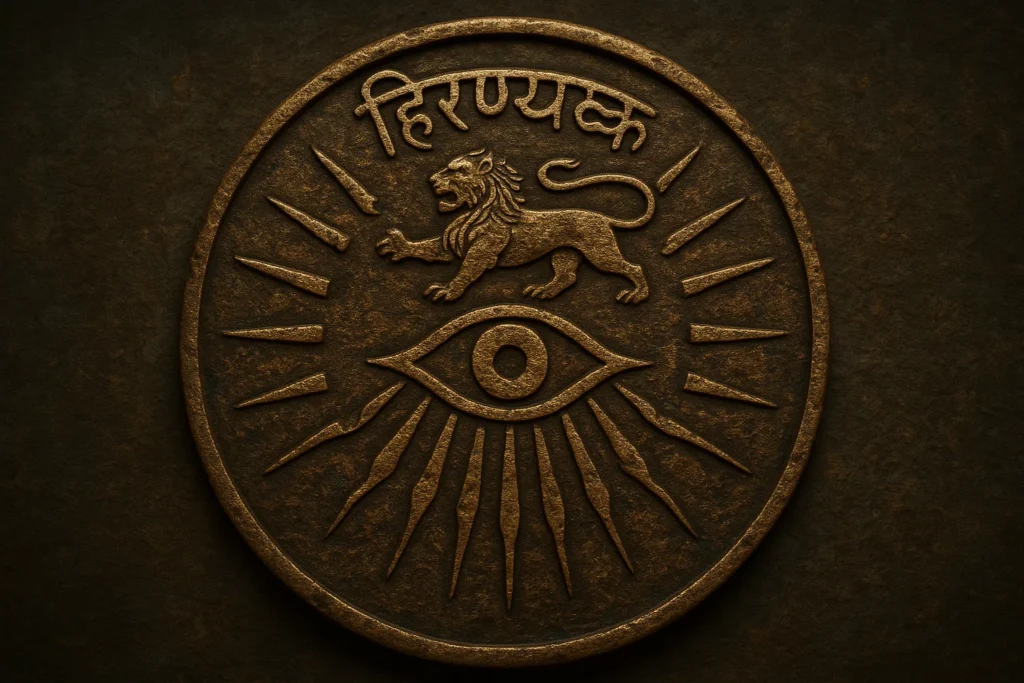
Mystical Correspondences
| Attribute | Details |
|---|---|
| Planet | Sun. |
| Zodiac Sign | Leo. |
| Element | Earth. |
| Direction | South. |
| Color | Gold. |
| Number | 1. |
| Crystal/Mineral | Ruby. |
| Metal | Gold. |
| Herb/Plant | Saffron. |
| Animal | Lion. |
| Trait/Role | Pride, conquest. |
Hiranyaksha‘s cosmic connections ground his power in the stars, with the Sun as his ruling planet, symbolizing light, power, and pride.
The Sun drives his bold actions, as seen in his attacks on the gods, through rites to call his energy, often set to coincide with the Sun’s strong times, such as Sunday mornings or Leo season (July 23–August 22).
His zodiac sign, Leo, is characterized by a fiery drive, propelling him in his endless pursuit of control over the world. This star setup enhances his warrior skills, as described in Puranic stories, where Hiranyaksha‘s gaze shines like the Sun, testing Varaha. Honoring Hiranyaksha during these periods, in some traditional ways, strengthens his presence, aligning his proud energy with the star cycles.
Moving from the stars to the physical realm, Hiranyaksha ties to the earth element, showing his act of sinking the land into water and his grounded strength.
In the Bhagavata Purana, his heavy pull on Bhumi reveals this earthy connection. At the same time, his golden name adds a shine of value. This earth connects to the south, the direction associated with depth and lower worlds in Vedic views, where Hiranyaksha‘s home in Patala is located.
Earth altars, used in his penance, direct this steady energy, keeping his boons strong. His earthy nature also shows in his mace, hitting like a quake, standing for his skill to shake both ground and sky.
These links flow into symbols that shape Hiranyaksha‘s nature. Gold as his color catches his bright eyes and wealth chase, while number 1 marks his lone stand against the gods.
Ruby as his stone boosts vitality, like his battle stamina, and gold metal fits his name’s core. Saffron herb ties to rites for power, and the lion animal shows its fierce roar.
Hiranyaksha’s Symbols
Hiranyaksha‘s main symbols include his mace, a heavy weapon that symbolizes his raw strength and battle skills. Golden eyes are another key feature, showcasing his bright yet intimidating gaze.
In some art, he holds items associated with earth or water, such as chains or waves, to evoke the sinking of the land.
Worship and Boons
Hiranyaksha gained his power through hard penance to Brahma, a process that lasted for many years to win favor. Methods included strict fasts, standing on one foot, and deep focus in remote locations such as mountains or forests.
Such tapasya, or self-control, is common for Asuras to obtain boons, demonstrating willpower over the body. Brahma, pleased, gave him safety from death by any god, man, or beast. He also got weapons and the skill to rule worlds.
However, this boon had a limitation, as it did not include a boar form. Gods, scared by his harm to earth, went to Brahma. Vishnu appeared and blessed that he would come as a human-like boar to end Hiranyaksha, since the boon skipped mixed forms.
No great worship of Hiranyaksha exists today, but his story teaches about the limits of boons and the risks of penance if used improperly.
You may also enjoy:
Who Is Jann in Islamic Mythology and Why Is He Feared?
October 2, 2025
Iblis, the Jinn King of Darkness and Deception
September 29, 2025
Vritra: The Dragon Who Swallowed the Sky in Hindu Mythology
October 7, 2025
What Is Qarin and Why Does It Follow Every Human Being?
October 8, 2025
Who Is Abalam in Demonology? The Terrifying King That Serves Paimon
September 30, 2025
Agubanba: The Ash-Born Demon of Japanese Folklore
October 23, 2025
